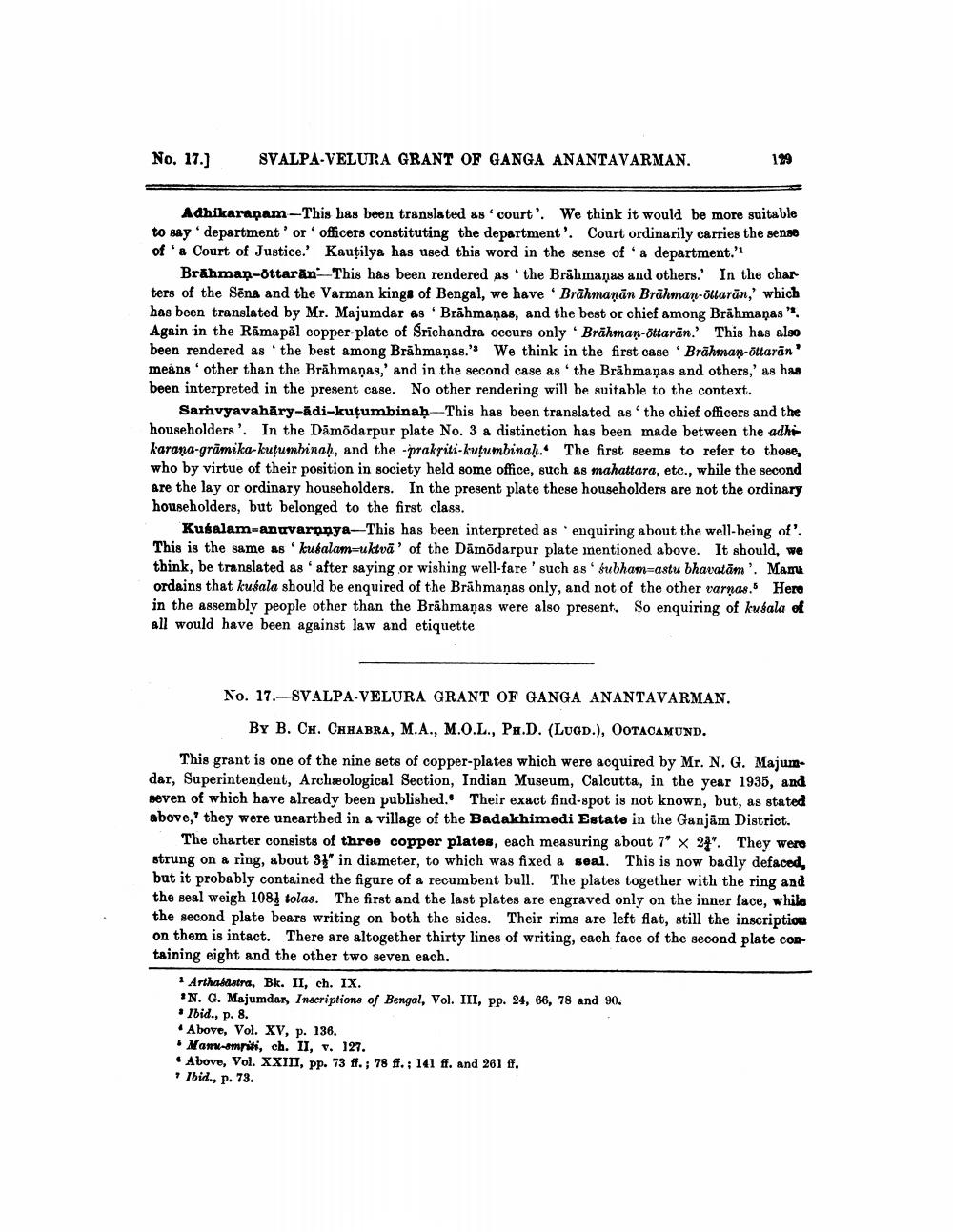________________
No. 17.]
SVALPA-VELURA GRANT OF GANGA ANANTAVARMAN.
Adhikaranam-This has been translated as 'court'. We think it would be more suitable to say department' or officers constituting the department'. Court ordinarily carries the sense of a Court of Justice.' Kautilya has used this word in the sense of a department."1
129
最
2
Brāhmaṇ-öttaran-This has been rendered as the Brahmanas and others.' In the char ters of the Sēna and the Varman kings of Bengal, we have Brāhmaṇān Brahman-ottaran,' which has been translated by Mr. Majumdar as Brahmanas, and the best or chief among Brahmaņas". Again in the Ramapal copper-plate of Srichandra occurs only Brahman-öttaran.' This has also been rendered as the best among Brāhmaṇas.' We think in the first case 'Brāhmaṇ-öttarān' means other than the Brahmanas,' and in the second case as the Brahmaņas and others,' as has been interpreted in the present case. No other rendering will be suitable to the context.
Samvyavahary-adi-kuṭumbinaḥ-This has been translated as the chief officers and the householders'. In the Damodarpur plate No. 3 a distinction has been made between the adhi karana-grāmika-kutumbinaḥ, and the -prakriti-kutumbinaḥ. The first seems to refer to those, who by virtue of their position in society held some office, such as mahattara, etc., while the second are the lay or ordinary householders. In the present plate these householders are not the ordinary householders, but belonged to the first class.
Kusalam-anuvarpnya-This has been interpreted as enquiring about the well-being of'. This is the same as 'kusalam-uktva' of the Damodarpur plate mentioned above. It should, we think, be translated as ' after saying or wishing well-fare' such as subham-astu bhavatām. Manu ordains that kusala should be enquired of the Brahmaņas only, and not of the other varnas. Here in the assembly people other than the Brahmaņas were also present. So enquiring of kusala of all would have been against law and etiquette.
No. 17.-SVALPA-VELURA GRANT OF GANGA ANANTAVARMAN.
BY B. CH. CHHABRA, M.A., M.O.L., PH.D. (LUGD.), OOTACAMUND.
This grant is one of the nine sets of copper-plates which were acquired by Mr. N. G. Majumdar, Superintendent, Archeological Section, Indian Museum, Calcutta, in the year 1935, and seven of which have already been published. Their exact find-spot is not known, but, as stated above, they were unearthed in a village of the Badakhimedi Estate in the Ganjam District.
The charter consists of three copper plates, each measuring about 7" x 24". They were strung on a ring, about 31" in diameter, to which was fixed a seal. This is now badly defaced, but it probably contained the figure of a recumbent bull. The plates together with the ring and the seal weigh 108 tolas. The first and the last plates are engraved only on the inner face, while the second plate bears writing on both the sides. Their rims are left flat, still the inscription on them is intact. There are altogether thirty lines of writing, each face of the second plate containing eight and the other two seven each.
1 Arthabastra, Bk. II, ch. IX.
N. G. Majumdar, Inscriptions of Bengal, Vol. III, pp. 24, 66, 78 and 90. Ibid., p. 8.
Above, Vol. XV, p. 136.
Manu-smriti, ch. II, v. 127.
Above, Vol. XXIII, pp. 73 ff.; 78 ff.; 141 ff. and 261 ff. Ibid., p. 73.




